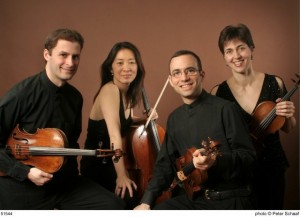BRENTANO STRING QUARTET, Libby Gardner Concert Hall, Oct. 6
Last night the Brentano String Quartet presented a wonderfully varied program of Mozart’s HuntQuartet, K. 458, Bartók’s Third and Elgar’s E minor, op. 83. Their performance was immaculately groomed, the result of years of painstaking collaboration. Unfortunately, though, they lacked the very humanity with which the music they so expertly played is fully imbued: the open joy of Mozart, the wild passion of Bartók, the restless pathos of Elgar. Grim and somber throughout, the Brentano had about as much cheer as a Mayan sacrifice.
And here’s where the dichotomy between a CD and a live performance comes into play. When a musician, literally, grits his teeth, and whose facial tension was almost painful to watch (first violinist Mark Steinberg); stares antagonistically at the music (violist Misha Amory); or almost perpetually shakes her head “no, no, no” with an accompanying scowl (cellist Nina Lee) it tends to dry up the perception of any reservoir of positive feeling they, or the audience, have about the music. An occasional, smiling “yes, yes, yes” would have been a welcome relief.
That’s not to say musicians should be something that they’re not and put on an act. Playing any classical music, let alone string quartets, requires a level of concentration that makes brain surgery seem like a weekend hobby. There’s no room to play pretend. Yet, there’s no getting around the fact that part of a live-concert experience is visual. We see how the performers feel about their mission, and you can’t totally divorce that from what you hear. That’s one of the reasons live concerts are irreplaceable. And if music is ultimately subjective, if the goal for the performing musician is to move the listener, to enrich the listener’s life experience, then the simulation of elation in the minuet of the Hunt, for example, is not enough. A simulation, no matter how practiced or how polished, is not the real thing. I think the audience sensed that, and responded accordingly.
Despite the Brentano’s immaculate intonation, flawless ensemble playing and sweet, willowy tone, there was a troubling divergence of approach to sound production among the individual musicians. Each had markedly different bow technique, and the result was telling. For example, in the last movement of the Elgar a short phrase was passed with rhythmic precision from one musician to the other – viola, second violin, first violin, cello – yet each played it with a mystifyingly different sound, fragmenting what should have been a unified line. Furthermore, Steinberg played excessively at the weakest part of the bow (the point), and much of what he played up there, especially quicker passages, was all but lost to the listener. There’s something to be said for lightness in Mozart, but sometimes you just have to address the string at the lower half of the bow and press the damn thing down. Second violinist Serena Canin, when she had the opportunity to play out, for instance in the second movement of the Elgar, had an expressively rich sound, but far too often had to sublimate her better instincts when trying to balance with Steinberg. Amory’s viola sound, by far the most focused and projecting, was intensely convincing, especially in the Elgar and Bartók, which is ironic as he is the only one whose instrument faced away from the audience. Lee’s visual dramatizations did not translate well into the aural realm. Her sound lacked depth and clarity of articulation. (I sat in the third row and even there I had to crane to hear the beginnings of notes.) And those Stephen King cello glissandos near the climax of the Bartók Third, which should raise the hair on the back of one’s neck, elevated nary a hackle.
For a string quartet, the upside of two decades of meticulous work is the ability to realize an almost unimaginable level of cohesion among four different human beings, and there’s no guarantee a quartet will get there, ever. The Brentano has achieved it in spades, for example, in the inner voice interplay between Canin and Amory, which was a pleasure to behold. The pitfall in such long-term collaborations, as one might guess, is that in the drive to attain so much polish the performance becomes antiseptic. How does a group maintain spontaneity after playing the same thing for decades? How does it avoid sounding like a series of well-rehearsed sections, rather than an integrated whole? It’s a never-ending, challenging paradox, and one that any performing ensemble, including the Brentano, must consider. I missed the fresh, unbounded optimism in the Mozart. The visceral, latent danger in the Bartók (where was the “pop” in the patented Bartók pizzicato?). That Thomas Hardy sense of ghostly presence permeating the Elgar.
After the concert I went home and watched a 40-year-old video of James Brown sing and dance on the Soul Train television show. Maybe the classical music concert hall is not ready for that level of raw, unrestrained passion, but on the other hand, it might not hurt.

